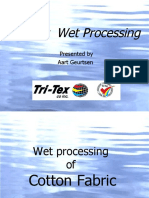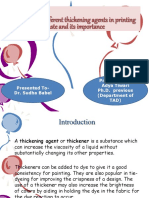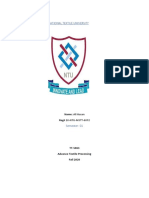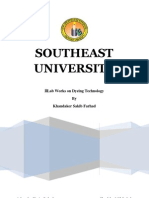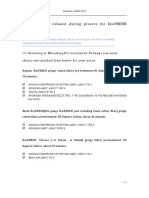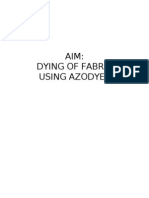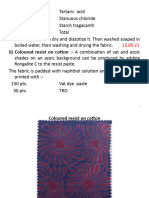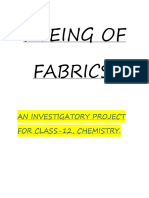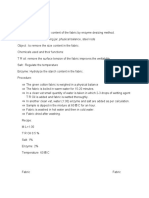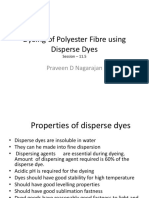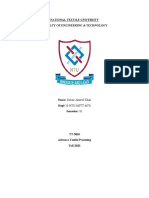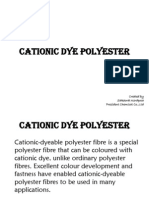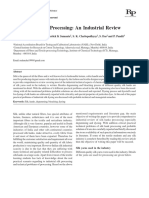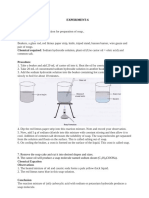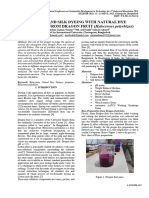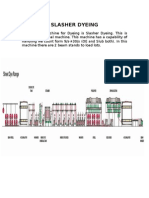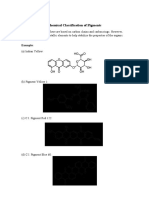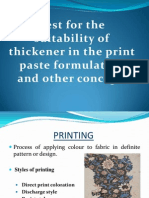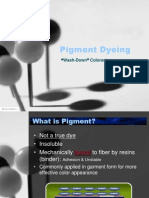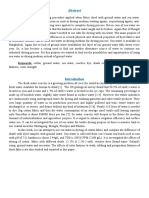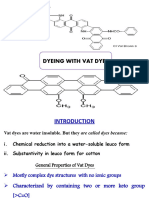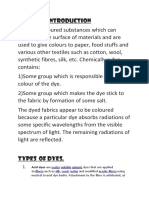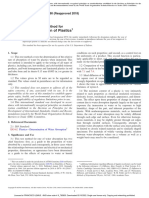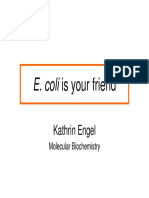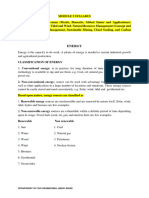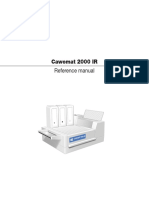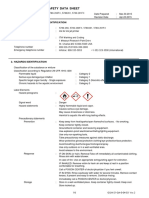Experiment No 8
Experiment No 8
Uploaded by
suriyanarayanan0308Copyright:
Available Formats
Experiment No 8
Experiment No 8
Uploaded by
suriyanarayanan0308Copyright
Available Formats
Share this document
Did you find this document useful?
Is this content inappropriate?
Copyright:
Available Formats
Experiment No 8
Experiment No 8
Uploaded by
suriyanarayanan0308Copyright:
Available Formats
CHEMICAL PROCESSING OF TEXTILES - II
Experiment No 8
Resist style (Batik Printing) of cotton fabrics with Reactive cold brand dyes
AIM: To print the given cotton bleached fabric with wax and dye using cold brand Reactive
dyes.
APPARATUS: Dye vessel, watch glasses, glass rod, graduated pipettes.
CHEMICALS: Paraffin wax, resin, common salt, soda ash, acetic acid.
PRINCEPLE:
‘Batik' is an Indonesian word describing a form of resist printing which, although known and
practiced as a native craft in south-east India, Europe and parts of Africa, has achieved an
unrivalled degree of craftsmanship in the Island of Java. It is a characteristic of the Java batik that
the resist is obtained by applying wax to both sides of the fabric. Dyeing is then carried out in the
cold to avoid melting the wax, thus confining the coloration to the unwaxed area. Selective further
waxing and re-dyeing allows a variety of colourings of increasing depth to be built up additively.
Where complete colour changes are required the wax is completely removed in boiling water and
the washed and dried cloth rewaxed to cover those areas that it is desired to protect from further
dyeing.
The cloth to be printed is first treated with a thin starch solution and ironed; this preliminary process
improves the results and tends to prevent undue penetration of the wax into the cloth. Usually, the wax is
printed on both the face and the back of the fabric, and the results are better if the wax is not allowed to
penetrate the cloth but rather to form layers on the two surfaces. In this way the edges of the objects appear
sharper in the final result. If a batik showing a 'crackle effect'is required, a resist consisting of a mixture of
paraffin wax and resin is used. A suitable mixture is one of 4 parts of rosin with 1 part of paraffin wax, or
3 parts of rosin with 1 part of paraffin wax should the rosin be a high-melting variety. The higher the
proportion of paraffin wax in the mixture the more brittle becomes the print and the more pronounced the
'cracking'.
RECIPE:
Sr. No. Ingredients and parameters Requirements
1 Procion M Dye (%) 2.0
3 Common salt (gpL) 35
4 Soda ash (gpL) 20
5 MLR 1:30
6 Temperature 30°C
7 Time (min) 60
DYE SOLUTION PREPARATION:
• Weigh 1g of dye.
• Make a paste using TR Oil.
DR SANJAY K B C PANDA, ASSOCIATE POFESSOR, IIHT VARANASI 1
CHEMICAL PROCESSING OF TEXTILES - II
• Add little water warm water and stir it.
• Add further warm water to make the total volume of 100 mL.
• This solution is now 1%.
• Pipette the required amount of dye using following formula.
𝑾∗𝑷
𝐃𝐲𝐞 (𝐦𝐥) =
𝑪
Where, W= weight of yarn, P= required % of shade, and C = concentration of dye solution.
CALCULATION:
Weight of cotton hank = X g
Total volume of Dye bath = (X*MLR) = V mL
Volume of Dye solution = A mL
Volume of acid = B mL
Volume of salt = C mL
Volume of water = (V-(A+B+C)) mL
PROCEDURE:
• Melt the paraffin wax in wax vessel.
• Using glass rods apply the melted wax on the fabric to make a design of your choice where you
want to resist the color.
• Air dry the fabric to harden the wax.
• Then dye the fabric in cold with reactive cold brand dyes.
• Once the dyeing is completed, remove the wax by boiling the fabric in hot water.
OBSEVATIONS:
CONCLUSION: The given cotton bleached fabric is printed in batik style using paraffin wax and
(Reactive cold band Dye Name) to x% shade as per the process recommended for Reactive dyeing.
QUESTIONS:
Q.1. What Batik printing?
Q.2. How to get a crackle effect in batik printing?
Q.3. Why do we advised to used cold brand dyes for batik printing?
Q.4. How can you remove the wax from the dyed fabric apart from boiling water technique?
DR SANJAY K B C PANDA, ASSOCIATE POFESSOR, IIHT VARANASI 2
You might also like
- Problems in Organometallic Chemistry For Web Page Sept 2011 Before CYP120Document3 pagesProblems in Organometallic Chemistry For Web Page Sept 2011 Before CYP120Etherion Eruto PhoenhaimuNo ratings yet
- Technical Specification For TankDocument19 pagesTechnical Specification For Tankhelard68100% (1)
- Rework, Modification and Repair of Electronic Assemblies: IPC-7711B/7721B Change 1 November 1, 2011Document20 pagesRework, Modification and Repair of Electronic Assemblies: IPC-7711B/7721B Change 1 November 1, 2011Daniel Martinez100% (1)
- Vce 03 Task. Ankit ChoudharyDocument5 pagesVce 03 Task. Ankit ChoudharyAnkit JaiswalNo ratings yet
- Garment Wet Processing: Presented by Aart GeurtsenDocument49 pagesGarment Wet Processing: Presented by Aart GeurtsenDyeing DyeingNo ratings yet
- Viscosity of Different Printing PasteDocument29 pagesViscosity of Different Printing Pastefathi mustafa100% (1)
- Bezaktiv S DyesDocument9 pagesBezaktiv S DyesAdil Malik100% (1)
- 2nd Lab ReportDocument13 pages2nd Lab Reportali hasan100% (2)
- Project ChemistryDocument13 pagesProject Chemistryarjunaaradhya5No ratings yet
- 11.1 Dyeing of Cotton With Vat DyesDocument10 pages11.1 Dyeing of Cotton With Vat DyesPraveen NagarajanNo ratings yet
- Textile Dyeing Document For Lab Matching With Various Dyes. (Exhaust Process)Document89 pagesTextile Dyeing Document For Lab Matching With Various Dyes. (Exhaust Process)Khandaker Sakib Farhad100% (1)
- Analysis of DyesDocument15 pagesAnalysis of DyesGaurav DhawanNo ratings yet
- Recommended Exhaust Dyeing Process For EcoFRESH Yarn V3 00-2015 12 (En)Document5 pagesRecommended Exhaust Dyeing Process For EcoFRESH Yarn V3 00-2015 12 (En)Saidur Rahman SajibNo ratings yet
- Preparing A Die SolnDocument7 pagesPreparing A Die SolnVinay KennyNo ratings yet
- Textile Printing IIDocument78 pagesTextile Printing IIHarsh ThakurNo ratings yet
- National Textile University Faculty of Engineering & TechnologyDocument11 pagesNational Textile University Faculty of Engineering & TechnologyShahan Akhtar100% (1)
- Dyeing of Fabrics. An Investigatory ProjDocument14 pagesDyeing of Fabrics. An Investigatory ProjDeepanshu RajputNo ratings yet
- Subject: Textile Finishing Presented To: Mr. SafdarDocument38 pagesSubject: Textile Finishing Presented To: Mr. Safdarjal pari100% (2)
- 4.1.04 Dyeing Polyester With Carrier - HTDocument2 pages4.1.04 Dyeing Polyester With Carrier - HTRakhsh KhorvashNo ratings yet
- Assignment 2 ChemesteryDocument26 pagesAssignment 2 ChemesterySIDDHARTH KOTHARINo ratings yet
- Soap Preparation Objective: Materials RequiredDocument3 pagesSoap Preparation Objective: Materials RequiredMeghanathi BhavinNo ratings yet
- 11.5 Dyeing of Polyester Fibre Using Disperse DyesDocument8 pages11.5 Dyeing of Polyester Fibre Using Disperse DyesPriya GhoshNo ratings yet
- Textile ProcessingDocument13 pagesTextile ProcessingSivaraj PadmanabanNo ratings yet
- National Textile University Faculty of Engineering & TechnologyDocument8 pagesNational Textile University Faculty of Engineering & TechnologyShahan AkhtarNo ratings yet
- Methods of ColorationDocument11 pagesMethods of ColorationFerdous Khan RubelNo ratings yet
- Textile AssignmentDocument8 pagesTextile AssignmentMahmudul Hasan Khan40% (5)
- Acid Dye InstructionsDocument2 pagesAcid Dye InstructionsAdiputra Iskandar100% (1)
- Cationic Dye PolyesterDocument10 pagesCationic Dye Polyesterrackmanager201267% (3)
- Method of Polyester DyeingDocument11 pagesMethod of Polyester DyeingNUR NOBINo ratings yet
- Dyeing of 100Document10 pagesDyeing of 100Sana KhanNo ratings yet
- Foundations of Textiles II Lab Manual 2022Document19 pagesFoundations of Textiles II Lab Manual 2022viovio7012No ratings yet
- Silk Yarn Processing An Industrial Review 201406Document7 pagesSilk Yarn Processing An Industrial Review 201406Linus F W WuNo ratings yet
- Disperse DyesDocument23 pagesDisperse DyesPratik Minj100% (3)
- Dry ProcessDocument11 pagesDry ProcessArunika OronnoNo ratings yet
- Contineous Dyeing of Reactive DyesDocument9 pagesContineous Dyeing of Reactive DyesMohammed Atiqul Hoque ChowdhuryNo ratings yet
- Lab Scale Soap ProductionDocument14 pagesLab Scale Soap Productionaimi wahabNo ratings yet
- Class 10 Chemistry Experiment 6docxDocument2 pagesClass 10 Chemistry Experiment 6docxchitraraj7579No ratings yet
- Session 12-14 Dyes - Application TypesDocument56 pagesSession 12-14 Dyes - Application TypesShagun Sinha100% (1)
- 11.5 Dyeing of Polyester Fibre Using Disperse DyesDocument6 pages11.5 Dyeing of Polyester Fibre Using Disperse DyespriyalNo ratings yet
- Cold Process MethodDocument14 pagesCold Process Methodflorence bumanlagNo ratings yet
- Chemical Processing of Textiles - I - CompressedDocument118 pagesChemical Processing of Textiles - I - CompressedOmkar Jadhav100% (1)
- Beam Dyeing MachineDocument65 pagesBeam Dyeing Machineنوشاد علیNo ratings yet
- Cotton and Silk Dyeing With Natural Dye EXTRACTED FROM DRAGON FRUIT (Hylocereus Polyrhizus)Document4 pagesCotton and Silk Dyeing With Natural Dye EXTRACTED FROM DRAGON FRUIT (Hylocereus Polyrhizus)carlokeisukeinuyashaNo ratings yet
- Slasher DyeingDocument14 pagesSlasher Dyeingengahsanraza100% (3)
- Reactive LectureDocument34 pagesReactive Lecturesanjay shetti100% (2)
- Vat Dye PDFDocument12 pagesVat Dye PDFImran100% (1)
- Presentation - WPT CLT IVDocument39 pagesPresentation - WPT CLT IVSaidul KarimNo ratings yet
- Topics: Thickener: Tariqul Islam Wet Processing-II (WPE-343) Lecturer (TECN)Document4 pagesTopics: Thickener: Tariqul Islam Wet Processing-II (WPE-343) Lecturer (TECN)ইমরানুল শহীদ আলভীNo ratings yet
- Wpt-III Lab Report 1Document4 pagesWpt-III Lab Report 1Rafid RatulNo ratings yet
- Chemical Classification of PigmentsDocument6 pagesChemical Classification of PigmentsPoison EmuNo ratings yet
- Dyeing Guide SilkDocument16 pagesDyeing Guide SilkmaheshboobalanNo ratings yet
- Dyeing With Polyester Using HTHP BEAM DYEING MACHINEDocument4 pagesDyeing With Polyester Using HTHP BEAM DYEING MACHINESivakumar KNo ratings yet
- Fiche Pratique Peinture Au Ble Version AnglaisDocument1 pageFiche Pratique Peinture Au Ble Version Anglaistselekidis71No ratings yet
- Printing of P.F VTH Vat& Sulphur DyesDocument4 pagesPrinting of P.F VTH Vat& Sulphur DyesMuhammad Asad NawazNo ratings yet
- Test For The Suitability of Thickener in The Print Paste Formulation and Other ConcepttestDocument21 pagesTest For The Suitability of Thickener in The Print Paste Formulation and Other ConcepttestGaurav Dhawan100% (1)
- Pigment Dyeing: "Wash-Down" ColorantDocument8 pagesPigment Dyeing: "Wash-Down" ColorantLeo ChoeNo ratings yet
- Dyeing of Cotton Fabric With Ground Water and Sea Water Comparison of Their Fastness PropertiesDocument11 pagesDyeing of Cotton Fabric With Ground Water and Sea Water Comparison of Their Fastness PropertiesNaimNo ratings yet
- 216949000Document7 pages216949000Wathsala VinodaniNo ratings yet
- Vat DyeingDocument37 pagesVat DyeingHayelom GirmayNo ratings yet
- Dyeing of FabricsDocument8 pagesDyeing of FabricsRoky IdiotNo ratings yet
- Exp no_ 1 soap and Detergent (1)Document8 pagesExp no_ 1 soap and Detergent (1)Priyanshu VarshneyNo ratings yet
- Bathtub and Shower Tray Repair: How to prevent remedials and make the repair future-proofFrom EverandBathtub and Shower Tray Repair: How to prevent remedials and make the repair future-proofNo ratings yet
- Vegetable Dyes: Being a Book of Recipes and Other Information Useful to the DyerFrom EverandVegetable Dyes: Being a Book of Recipes and Other Information Useful to the DyerNo ratings yet
- Solvoya® CP6202-XSM: Technical DatasheetDocument1 pageSolvoya® CP6202-XSM: Technical DatasheetI Love MusicNo ratings yet
- 1 s2.0 S088915752200134X MainDocument6 pages1 s2.0 S088915752200134X Mainmarcela cadenaNo ratings yet
- Water Absorption of Plastics: Standard Test Method ForDocument4 pagesWater Absorption of Plastics: Standard Test Method ForjoseNo ratings yet
- 6 Petrology - Atomic Substitution, Phase and Igneous DiagramsDocument50 pages6 Petrology - Atomic Substitution, Phase and Igneous DiagramsClifford Cobsilen Jr.No ratings yet
- Class 12 Chemistry Revision Notes ElectrochemistryDocument25 pagesClass 12 Chemistry Revision Notes ElectrochemistrySariska MehraNo ratings yet
- Conserving Biodiversity (5.3) : State StandardDocument33 pagesConserving Biodiversity (5.3) : State Standardayu711100% (1)
- Wifpl Qap 2019-20-015 Rev 00 Mdns 40ni6cr4mo3 SignedDocument3 pagesWifpl Qap 2019-20-015 Rev 00 Mdns 40ni6cr4mo3 SignedDeipak HoleNo ratings yet
- Covalent MoleculesDocument3 pagesCovalent MoleculesElizabeth PhillipsNo ratings yet
- Phsv03i03p0211 PDFDocument4 pagesPhsv03i03p0211 PDFphysicsjournalNo ratings yet
- Molylube Open Gear & Rope LubricantDocument2 pagesMolylube Open Gear & Rope LubricantdhowardjNo ratings yet
- E. Coli Is Your Friend: Kathrin EngelDocument37 pagesE. Coli Is Your Friend: Kathrin EngelcambodianpisethNo ratings yet
- PDBO0A102Document24 pagesPDBO0A102LucioRimacNo ratings yet
- Practical Work N°1 Solution PreparationDocument7 pagesPractical Work N°1 Solution PreparationHattali AhlemNo ratings yet
- Metallurgy and Welding PDFDocument18 pagesMetallurgy and Welding PDFPatrick DominguezNo ratings yet
- Agilent 700 Series ICP-OESDocument52 pagesAgilent 700 Series ICP-OESRoger ManzanarezNo ratings yet
- Chymotrypsin's Function Through StructuralDocument2 pagesChymotrypsin's Function Through StructuralBhavya ThakuriaNo ratings yet
- Procedure For Proper Chemical StorageDocument5 pagesProcedure For Proper Chemical StorageDavish GurriahNo ratings yet
- Module 2 Evs 21civ57Document14 pagesModule 2 Evs 21civ57iamjarvis990No ratings yet
- DNA - RNA Nice MaterialDocument54 pagesDNA - RNA Nice MaterialLovryan Tadena AmilingNo ratings yet
- FB Tank Level Indicator Industrial SeriesDocument2 pagesFB Tank Level Indicator Industrial SeriesArter PandaanNo ratings yet
- Assignment No 12 Solder Assignment-1Document4 pagesAssignment No 12 Solder Assignment-1Priyanka KambleNo ratings yet
- JSW CementDocument32 pagesJSW CementChandra SekarNo ratings yet
- Bio Cleaning, Passivation & Regular Treatment StartupDocument2 pagesBio Cleaning, Passivation & Regular Treatment Startupasimkumarmaity0007No ratings yet
- Cawomat 2000 IR - Reference ManualDocument142 pagesCawomat 2000 IR - Reference ManualIM100% (1)
- Safety Data Sheet: 1. Product and Company IdentificationDocument6 pagesSafety Data Sheet: 1. Product and Company IdentificationPablo Orrico100% (1)
- Shell Tellus S2 MX 46: Performance, Features & BenefitsDocument3 pagesShell Tellus S2 MX 46: Performance, Features & Benefitsphucdc095041No ratings yet
- Brief DLC Presentation - ELecor PDFDocument16 pagesBrief DLC Presentation - ELecor PDFJoão TarelhoNo ratings yet




